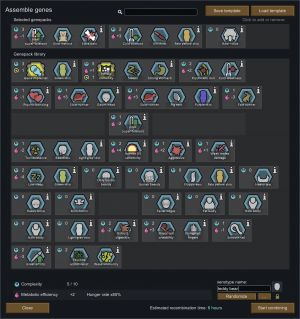Gene assembler
| This article relates to content added by Biotech (DLC). Please note that it will not be present without the DLC enabled. |
| This article is a stub. You can help RimWorld Wiki by expanding it. Reason: An analysis of factors on recombination time. A gene-editing strategy guide, or a link to one somewhere else. |
Gene assembler
A workbench for creating implantable xenogerms from genepacks stored in nearby gene banks. Genepacks are not consumed in this process and can be reused.
Base Stats
Building
- Size
- 2 × 3
- Minifiable
- False
- Placeable
- True
- Passability
- PassThroughOnly
- Cover Effectiveness
- 0%
- Terrain Affordance
- Light
- Power
- -100 W
Creation
- Required Research
- Xenogenetics
- Skill Required
- Construction 4
- Work To Make
- 12,000 ticks (3.33 mins)
The gene assembler assembles one or more xenogenes into an implantable xenogerm.
Acquisition
Gene assemblers can be constructed once the Xenogenetics research project has been completed. They require ![]() 200 Steel,
200 Steel, ![]() 4 Components, 12,000 ticks (3.33 mins) of work, and a Construction skill of 4.
4 Components, 12,000 ticks (3.33 mins) of work, and a Construction skill of 4.
Summary
The gene assembler must be connected to nearby gene banks, which must contain genepacks. The gene assembler can access the genes in these stored genepacks, and reassemble them into an implantable xenogerm.
Using the gene assembler, you can combine your genepacks for your own desired custom xenotype. Any type and number of gene can be added, as long as no genes conflict, and as long as you do not exceed the maximum genetic complexity, or the minimum metabolic efficiency.
 Genetic Complexity
Genetic Complexity
By default, the assembler's maximum genetic complexity is 6. The maximum complexity is raised by 2 for each gene processor that is currently connected and active. Up to 100 processors can be connected, for a hard maximum of 206 complexity.
Gene processors will only contribute complexity when powered. If the connected processors lose power during recombination, and the maximum complexity falls below the xenogerm's requirement, then recombination will be put on hold.
 Metabolic Efficiency
Metabolic Efficiency
Nearly all non-cosmetic genes will affect your pawn's metabolic efficiency, which in turn affects their hunger rate. A higher metabolic efficiency represents a pawn that uses less energy, and requires less food. Likewise, a lower metabolic efficiency represents a hungrier pawn that requires more food. There is a tradeoff, where positive genes result in lower efficiency, and negative genes result in a higher efficiency (with a few exceptions).
A valid gene combination requires a metabolic efficiency of -5 or higher, resulting in a maximum of 225% hunger rate. Positive, efficiency-lowering genes must be balanced out by negative, efficiency-raising genes for the xenogerm to become valid. Any number of efficiency-raising genes can be applied, but the effect will only stack up to +5 efficiency, at a minimum of 50% hunger rate. Any more genetic efficiency beyond this point will have no effect.
 Archite Capsules
Archite Capsules
It is also possible to include any number of archite genes into your xenogerm. However, each archite gene requires some number of archite capsules, which must be loaded into the assembler to begin recombination.
Once you are done customizing your xenotype, a researcher will begin processing the xenogerm. The process takes a few hours, or even days, depending on the xenogenes selected[Check]. When finished, a completed xenogerm will be dropped onto the ground nearby. This process does not require any resources, apart from archite capsules if necessary.
Version history
- Biotech DLC Release - Added

